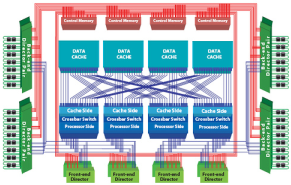Architectural Exploration
Several customers use OMNEST for the architectural exploration of high-performance computing systems, such as the design of fast interconnects, network-on-chip architectures, and more.

Benefits
The component architecture helps you deal with complexity by allowing you to build the model hierarchically in a top-down or bottom-up fashion. Components can represent any level of detail that is appropriate for your simulation study, from high-level functional models down to cycle-accurate models. The component architecture also makes it possible to have multiple implementations with varying levels of detail for a given component or to replace a single component with a composite one. These features allow you to write the simulation model at the appropriate abstraction level and still have the flexibility to modify it later.
Some more points to consider:
- Existing models may be useful for your project; see the Simulation Models page for more information.
- Simulation performance is ensured by careful design and the use of C++ for both models and the simulation kernel and library.
- Parallel simulation capability is available for speeding up model execution and for distributing memory requirements when needed.
- SystemC integration. If you are simulating hardware, OMNEST's SystemC integration feature can be useful. Both RTL and higher-level SystemC modules can be used in OMNEST simulations without any performance loss.
- Hardware-in-the-loop (emulation) and co-simulation (connecting an OMNEST simulation to other simulators) are also within reach.

Case Studies
- Simulation of Next-Generation Supercomputing Systems at IBM Research
- Architectural Exploration of Chip-Scale Photonic Interconnection Networks
- Improving the Performance of InfiniBand in a Supercomputing Cluster
